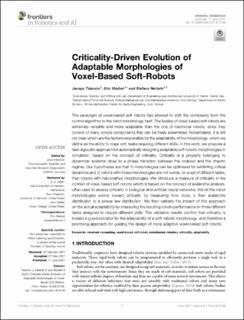| dc.contributor.author | Talamini, Jacopo | |
| dc.contributor.author | Medvet, Eric | |
| dc.contributor.author | Nichele, Stefano | |
| dc.date.accessioned | 2021-08-05T08:51:15Z | |
| dc.date.available | 2021-08-05T08:51:15Z | |
| dc.date.created | 2021-07-01T14:17:32Z | |
| dc.date.issued | 2021-06-17 | |
| dc.identifier.issn | 2296-9144 | |
| dc.identifier.uri | https://hdl.handle.net/11250/2766383 | |
| dc.description.abstract | The paradigm of voxel-based soft robots has allowed to shift the complexity from the control algorithm to the robot morphology itself. The bodies of voxel-based soft robots are extremely versatile and more adaptable than the one of traditional robots, since they consist of many simple components that can be freely assembled. Nonetheless, it is still not clear which are the factors responsible for the adaptability of the morphology, which we define as the ability to cope with tasks requiring different skills. In this work, we propose a task-agnostic approach for automatically designing adaptable soft robotic morphologies in simulation, based on the concept of criticality. Criticality is a property belonging to dynamical systems close to a phase transition between the ordered and the chaotic regime. Our hypotheses are that 1) morphologies can be optimized for exhibiting critical dynamics and 2) robots with those morphologies are not worse, on a set of different tasks, than robots with handcrafted morphologies. We introduce a measure of criticality in the context of voxel-based soft robots which is based on the concept of avalanche analysis, often used to assess criticality in biological and artificial neural networks. We let the robot morphologies evolve toward criticality by measuring how close is their avalanche distribution to a power law distribution. We then validate the impact of this approach on the actual adaptability by measuring the resulting robots performance on three different tasks designed to require different skills. The validation results confirm that criticality is indeed a good indicator for the adaptability of a soft robotic morphology, and therefore a promising approach for guiding the design of more adaptive voxel-based soft robots. | en_US |
| dc.description.sponsorship | This work has been partly financed by Project CA4VSR, grant agreement 312537, Forskermobilitet, Research Council of Norway, and Project DeepCA, grant agreement 286558, Young Research Talent, Research Council of Norway. | en_US |
| dc.language.iso | eng | en_US |
| dc.publisher | Frontiers Media | en_US |
| dc.relation.ispartofseries | Frontiers in Robotics and AI;1 June 2021 | Volume 8 | Article 673156 | |
| dc.relation.uri | https://www.frontiersin.org/articles/10.3389/frobt.2021.673156/full | |
| dc.rights | Navngivelse 4.0 Internasjonal | * |
| dc.rights.uri | http://creativecommons.org/licenses/by/4.0/deed.no | * |
| dc.subject | Reservoir computing | en_US |
| dc.subject | Voxel-based soft robots | en_US |
| dc.subject | Evolutionary robotics | en_US |
| dc.subject | Criticality | en_US |
| dc.subject | Adaptability | en_US |
| dc.title | Criticality-Driven Evolution of Adaptable Morphologies of Voxel-Based Soft-Robots | en_US |
| dc.type | Peer reviewed | en_US |
| dc.type | Journal article | en_US |
| dc.description.version | publishedVersion | en_US |
| dc.rights.holder | Copyright © 2021 Talamini, Medvet and Nichele. | en_US |
| dc.source.articlenumber | 673156 | en_US |
| cristin.ispublished | true | |
| cristin.fulltext | original | |
| cristin.qualitycode | 1 | |
| dc.identifier.doi | https://doi.org/10.3389/frobt.2021.673156 | |
| dc.identifier.cristin | 1919874 | |
| dc.source.journal | Frontiers in Robotics and AI | en_US |
| dc.source.volume | 8 | en_US |
| dc.source.pagenumber | 1-15 | en_US |
| dc.relation.project | Norges forskningsråd: 286558 | en_US |
| dc.relation.project | Project CA4VSR: 312537 | en_US |

